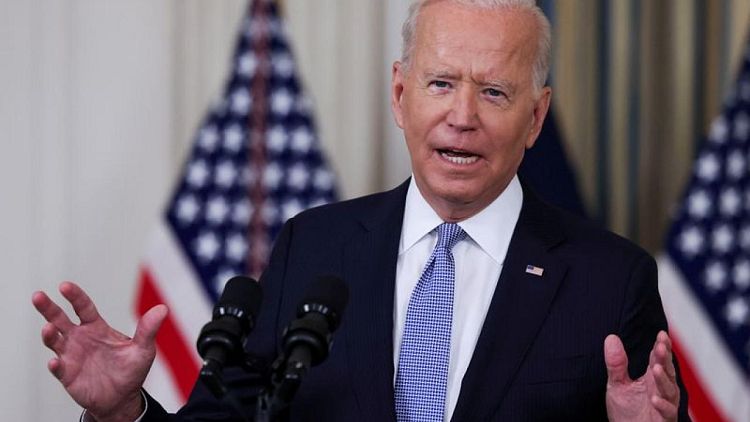By Susan Cornwell
WASHINGTON - Faced with the risk of the U.S. federal government defaulting on its debt in the next two weeks, President Joe Biden on Tuesday for the first time said he was open to a one-time change in the Senate's filibuster custom to bypass a Republican roadblock.
Some Senate Democrats this year have suggested changing the rule, which requires 60 of the chamber's 100 members to agree to pass most legislation, in the face of Republican opposition in the narrowly divided chamber.
Biden spent 36 years in the Senate and had previously said he opposed changes to the filibuster tradition. Tuesday he said it was a "real possibility" Democrats would bypass the filibuster to prevent a debt default https://www.reuters.com/world/us/schumer-sets-us-debt-ceiling-vote-wednesday-tensions-rise-2021-10-05.
WHAT IS THE FILIBUSTER?
To "filibuster" means to delay action on a bill or other issue by talking.
The Senate filibuster first captured the American imagination in Frank Capra's 1939 movie "Mr. Smith Goes to Washington," when Jimmy Stewart's character spoke for more than a day, and more recently in 2013 when Texas state Senator Wendy Davis spoke for 13 hours to try to block a bill imposing new restrictions on abortion.
The popular image of a lone lawmaker mounting an impassioned hours-long argument belies the reality in today's Senate, where a mere threat is enough to initiate a filibuster and hold up a bill.
A filibuster can only be stopped if a supermajority of 60 senators vote to end debate in a process called cloture.
WHY IS THE RULE A PROBLEM FOR DEMOCRATS?
With just 50 senators, Democrats are currently not able to overcome filibusters unless at least 10 Republicans vote with them.
Democrats were able to pass Biden's $1.9 trillion COVID-19 stimulus plan without a supermajority through another Senate maneuver called "reconciliation," with the help of Vice President Kamala Harris's tie-breaking 51st vote. But the rules limit the use of that process.
Though they did get 19 Republican votes for a $1 trillion package to revamp the nation's roads, bridges and other infrastructure, Republicans have blocked many other Democratic priorities including a voting-rights measure. Senate Minority Leader Mitch McConnell has blocked a vote to lift the debt ceiling, raising the risk of a catastrophic default.
That changed the stakes for Biden.
WHEN DID THE SENATE ADOPT THE FILIBUSTER RULE?
Although the U.S. Constitution makes no mention of filibusters, long-winded Senate speeches became an increasingly common tactic in the 19th century.
By 1917 most senators had had enough, agreeing that a vote by a two-thirds majority could end debate.
But getting two-thirds of the Senate was hard, so filibusters continued. Notoriously, they were used by southern senators who sought to block civil rights laws.
In 1975, the Senate reduced the requirement for limiting debate to three-fifths of the Senate - currently 60 senators.
In that decade, the Senate leadership began agreeing to allow measures that were facing a filibuster to be put aside while the chamber acted on other bills.
The move was intended to prevent opposition to a single bill bringing all work in the chamber to halt, but it also meant that the filibuster changed from an energy-draining maneuver involving lengthy speeches to a mere objection, or threat to object.
Over time the number of filibusters skyrocketed. There is no sure-fire way of counting how many bills are filibustered in a year because of the nebulous nature of the threats. But a count of votes to try to overcome a filibuster, the nearest reliable proxy, shows 298 such votes in the 2019-2020 legislative session. That's up from 168 such votes in the previous two years. In 1969-1970 there were six.
Putting filibustered bills aside "made filibustering actually more successful, and even less costly, which was not intended. And it might have, paradoxically, made things worse," said Sarah Binder, a political science professor at George Washington University who co-wrote a book on the filibuster.
CAN THE FILIBUSTER BE CHANGED?
There have already been changes, in addition to changing the number of votes required for cloture.
In 2013, Democrats removed the 60-vote threshold for voting on most nominees for administration jobs, apart from the Supreme Court, allowing them to advance on a simple majority vote.
In 2017, Republicans did the same thing for Supreme Court nominees. Both the 2013 and 2017 changes were made by simple majority votes.
One question that arises is whether, after making an exception to the rule to avert a debt crisis, whether Democrats -- or a future Republican majority -- would further limit use of the filibuster, or eliminate it entirely.
WHO OPPOSES CHANGE?
McConnell, for one. At the start of this year he tried but failed to get an explicit promise from his Democratic counterpart Chuck Schumer to protect the filibuster.
At least two Senate Democrats, Joe Manchin and Kyrsten Sinema, both centrists, have also voiced support for the 60-vote threshold. Without them, Schumer does not have the majority needed to gut the rule.
Manchin and Sinema could not be reached for immediate comment on Tuesday as to whether Biden's change of heart and the looming debt crisis, would change their stance.
